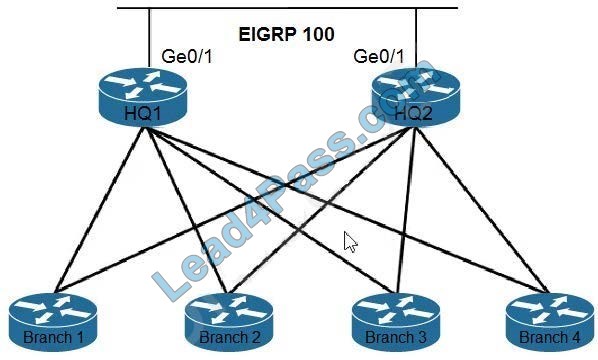
leads4pass 300-420 dumps prepare 225 latest exam questions and answers for candidates taking the 300-420 ENSLD exam, the most effective solution for 2023.
To successfully pass the 300-420 ENSLD exam in 2023, download Cisco 300-420 dumps: https://www.leads4pass.com/300-420.html, and provide PDF and VCE learning tools to help candidates improve efficiency.

Read some leads4pass 300-420 dumps exam questions and answers online:
| Number of exam questions | Exam name | Exam code | Last updated |
| 15 | Designing Cisco Enterprise Networks (ENSLD) | 300-420 | 300-420 dumps |
Question 1:
Which consideration must be taken into account when using the DHCP relay feature in a Cisco SD-Access Architecture?
A. DHCP-relay must be enabled on fabric edge nodes to provide the correct mapping of DHCP scope to the local anycast gateway.
B. A DHCP server must be enabled on the border nodes to allow subnets to span multiple fabric edges.
C. DHCP servers must support Cisco SD-Access extensions to correctly assign IPs to endpoints in an SD-Access fabric with anycast gateway.
D. DHCP Option-82 must be enabled to map the circuit IP option to the access fabric node where the DHCP discovery originated.
Correct Answer: D
Question 2:
Which design consideration must be made when dual vEdge routers are deployed at a branch site?
A. Use BGP AS-path prepending to influence egress traffic and use MED to influence ingress traffic from the branch.
B. HSRP priorities must match the OMP routing policy to prefer one vEdge over the other.
C. Traffic must be symmetrical as it egresses the vEdges and returns from remote sites for DPI to function properly.
D. Configure BFD between vEdge routers to detect sub-second link failures.
Correct Answer: A
Question 3:
How are wireless endpoints registered in the HTDB in a Cisco SD-Access architecture?
A. Fabric edge nodes update the HTDB based on CAPPWAP messaging from the AP
B. Fabric WLCs update the HTDB as new clients connect to the wireless network
C. Border nodes first register endpoints and then update the HTDB
D. Fabric APs update the HTDB with the clients\’ ElD and RLOC
Correct Answer: B
Question 4:
Refer to the exhibit.

The full EIGRP routing table is advertised throughout the network. Currently, users experience data loss when any one link in the network fails. An architect must optimize the network to reduce the impact when a link fails. Which solution should the architect include in the design?
A. Run BFD on the interlinks between EIGRP neighbors.
B. Summarize the access layer networks from each access layer switch toward the aggregation layer.
C. Reduce the default EIGRP hello interval and hold time.
D. Summarize the access layer networks from the aggregation layer toward the core layer.
Correct Answer: A
Question 5:
Which OSPF area blocks LSA Type 3, 4, and 5, but allows a default summary route?
A. normal
B. stub
C. NSSA
D. totally stubby
Correct Answer: D
Question 6:
An engineer uses Postman and YANG to configure a router with: OSPF process ID 400 network 192.168.128.128/25 enabled for Area 0
Which get-config reply verifies that the model set was designed correctly?

A. Option A
B. Option B
C. Option C
D. Option D
Correct Answer: B
Question 7:
In an SD-WAN architecture, which methods are used to bootstrap a vEdge router?
A. DHCP options or manual configuration
B. manage or DNS records
C. ZTP or manual configuration
D. DNS records or DHCP options
Correct Answer: C
Question 8:
Which type of rendezvous point deployment is standards-based and supports dynamic RP discovery?
A. Auto-RP
B. Anycast-RP
C. bootstrap router
D. static RP
Correct Answer: C
Question 9:
Refer to the exhibit. An architect must create a stable and scalable EIGRP solution for a customer. The design must:
1.
conserve bandwidth, memory, and CPU processing
2.
prevent suboptimal routing
3.
avoid any unnecessary queries
Which two solutions must the architect select? (Choose two.)

A. route summarization
B. prefix lists
C. distribute lists
D. stub routing
E. static redistribution
Correct Answer: AC
Question 10:
Which two functions are provided by the Cisco SD-WAN orchestration plane? (Choose two.)
A. centralized provisioning
B. primary authentication point
C. NAT traversal facilitation
D. Zero Touch Provisioning
E. troubleshooting and monitoring
Correct Answer: BC
Question 11:
At which layer does Cisco Express Forwarding use adjacency tables to populate addressing information?
A. Layer4
B. Layer 2
C. Layer 1
D. Layer 3
Correct Answer: B
Question 12:
Refer to the exhibit. An engineer is designing a BGP solution for a client that peers with ISP1 for full Internet connectivity and with ISP2 for direct exchange of routes for several third parties. Which action, when implemented on the edge routers, enables the client network to reach the Internet through ISP1?

A. Run an eBGP session within different VRFs for each ISP.
B. Advertise a default route for downstream routers within the client network.
C. Apply the AS-path prepend feature for ISP2.
D. Apply route filtering such that the client advertises only routes originating from its own AS.
Correct Answer: B
Question 13:
DRAG DROP
Drag and drop the characteristics from the left onto the Yang model they describe on the right.
Select and Place:

Correct Answer:

Question 14:
Which PIM mode uses a shared tree only?
A. bidirectional
B. sparse
C. dense
D. source-specific
Correct Answer: A
In bidirectional mode, traffic is routed only along a bidirectional shared tree that is rooted at the rendezvous point (RP) for the group https://www.cisco.com/c/en/us/td/docs/ios-xml/ios/ipmulti_pim/configuration/xe-16/imc-pim-xe-16-book/imc-tech-oview.html
Question 15:
What is the purpose of a Cisco SD-Access underlay network?
A. to abstract IP-based connectivity from physical connectivity
B. to emulate LAN segments to transport Layer 2 frames over a Layer 3 network
C. to establish physical connectivity between switches and routers
D. to provide virtualization by encapsulating network traffic over IP tunnels
Correct Answer: C
…
If the 300-420 ENSLD exam is your plan in 2023, then please use leads4pass 300-420 dumps: https://www.leads4pass.com/300-420.html, to help you pass successfully on the first try.